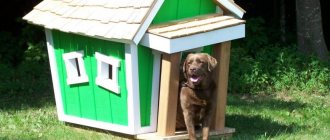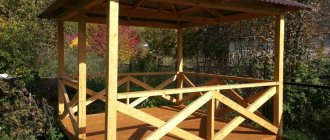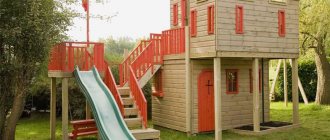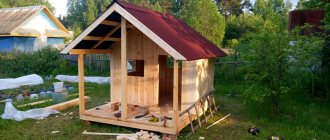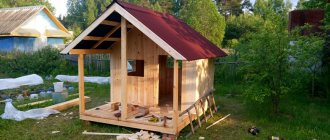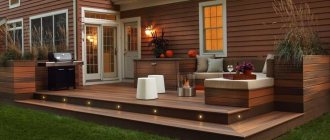An insulated, spacious kennel is a guarantee of excellent mood and good health for the dog. Keeping your pet in damp and cold for a long time will certainly lead to the development of illnesses.
You can make a house for an animal yourself within a few hours, without spending money on expensive ready-made structures.
You should first consider the design of the building and choose the preferred material for interior and exterior decoration. Once inspired with ideas, you can get to work.
Dimensions of the kennel
Design parameters depend on the size of the dog. In a small building the animal will be cramped and stuffy, in a large building it will be cold. In order for the depth of the kennel to be suitable, it is necessary to determine the length from the tip of the tail to the dog’s nose.
The height of the kennel is calculated by measuring the animal at the withers, adding an additional 5 cm to the resulting figure.
The dimensions of the manhole are calculated based on the dog’s chest circumference, plus 5 centimeters. The entrance opening is made 3-5 cm wider in height.
For small dachshunds, miniature poodles, and Pekingese, a booth with dimensions of 70x55x60 cm is suitable. At the same time, the entrance to the building can be made with dimensions of 30x40 cm.
For bulldogs and Rottweilers, a design format of 115x75x80 cm is suitable, and the dimensions of the entrance opening can be made 35x50cm.
A kennel for shepherd dogs is built with dimensions of 135x100x95 cm, while the parameters of the opening should be 40x60 cm.
Frame Installation: Complete Guide
When building a booth from plywood, covering it with fabric inside and decorating the outside, the main load is borne by the frame. Its assembly begins with connecting the bottom and side walls. First, the bottom and floor are cut out if you plan to make it double, so that you can take the booth out into the yard at the dacha.
The next step is assembling the side walls - cutting out sections of bars for the vertical posts and horizontal crossbars. The connection is made using self-tapping screws.
Note! Before screwing in the screw, you need to make a hole with a drill of a smaller diameter so that the wood does not crack.
After assembling the side walls, the front and rear walls are installed. To strengthen the structure, the inside is lined with thin plywood or chipboard. The sheathing is secured with small nails.
Plywood house
Schemes and drawings
For a lightweight structure, you can sketch a diagram with a pencil on a piece of paper with the dimensions of the building. When building a more complex structure, you will need a drawing with precise measurements. It is important to take into account the following features:
- The interior space of the house should be comfortable and spacious so that the dog can turn around freely. It is better for the puppy to make a large booth right away, understanding that he will grow up quickly;
- the presence of unnecessary elements in the form of partitions, ledges and stairs will create inconvenience for the dog;
- An excellent option is a rectangular house with a side entrance and a removable pitched roof;
- It is advisable to make one wall removable for weekly cleaning of the house;
- a gable cornice is optimal for a small kennel when you need to increase the size of the internal space.
Requirements for a dog house
The dog’s small home needs to be made spacious. It should be of optimal size so that the dog can calmly lie down to rest.
It is better to take natural materials for this undertaking. They are environmentally friendly and do not cause allergies. If these are fabrics, then jeans, coarse linen, tarpaulin, and cotton are suitable. And also felt: it is warm, thick and soft. Fleece can be used for synthetic fabrics. But upon contact with wool, such material can become electrified. The most comfortable and wear-resistant houses are made of wood, while houses made of cardboard are less durable and practical.
In order for the home to withstand the impact of the dog’s claws and teeth, you should take only coarse fabrics and other additions (thick threads, metal fittings). Otherwise, the product will not last long. The size of the dog and the breed also matter. If a house made of foam rubber is suitable for small animals (less than 20 kg), then for large animals you need something more massive. For example, a wooden booth.
Expert opinion
Anna Abramenko
An avid dog lover. Experience in veterinary medicine since 2009.
Ask a Question
The house should not be too hot so that the dog feels comfortable in it. It is necessary to take into account the temperature in the apartment and the degree of shaggyness of the animal. And based on this, choose materials for your home. For shaggy pets, linen or cotton is more suitable than faux fur.
Tools and materials
When the drawing is made, we begin to select the material. The most popular wood for building a kennel is soft coniferous wood, which is characterized by heat retention, environmental friendliness, and reasonable cost.
In areas with cold climatic conditions, it is better to choose a construction option made of a three-layer log profile with special insulation between the panels.
In order not to be distracted by purchasing additional tools and materials during construction, it is advisable to prepare them in advance:
- Dry beams - 10x10 cm; 10x50 cm;
- block 2.5 cm thick;
- boards 4x4 cm;
- upholstery strip;
- door hinges;
- roofing felt sheet;
- nails;
- Styrofoam;
- hammer;
- antiseptic solution.
Important! “Building materials should be thoroughly sanded to avoid injury to the pet’s paws. It is advisable to treat wood with antiseptic impregnation after completing the assembly of the house and only from the outside: pungent odors can cause fear in the animal and reluctance to be in the booth.”
Manufacturing process
To make a dog house with your own hands from a box, you need to use the drawing developed earlier. Each detail is transferred to sheets of paper. Next, they are cut out and transferred to cardboard.
After this, you need to use a sharp stationery knife. With its help, all the details of the future house are cut out. You need to act very carefully so that the edges are even. You can use scissors for these purposes, but only when assembling houses for small breed dogs. Thinner cardboard is suitable for them.
All parts are fastened with tape. If the cardboard is thick and the house is large, it is better to use special glue. This will make the structure durable. Particular attention should be paid to the corners.
Next you need to cover the booth with wallpaper. It is best to choose washable varieties. As they become dirty, you can clean them with a damp cloth. A booth covered with fabric looks impressive. It can be any fluffy textile. The house will immediately become more comfortable and warmer. You can paint the structure with paints.
Building with a pitched roof
To protect the animal from the cold, it is recommended to insulate the house, directly during the assembly of the structure.
Stage 1. Assembling the bottom box
4x4 cm bars are cut based on the parameters of the bottom, laid out on a flat surface, and secured with self-tapping screws into a rectangle. For a large dog, the frame is reinforced with a wooden plank, and then one side with boards.
Stage 2. Floor insulation
The upholstered frame is placed so that the bars are on top. The inner part is lined with glassine, fixed with staples using a stapler, a piece of foam is cut with scissors based on the dimensions, and laid out between the wooden parts.
At the top, the synthetic material is covered with an additional layer of rolled glassine and the finishing floor is nailed.
Stage 3. Frame assembly
A 10 x 10 cm board is sawn into 4 pieces: two at a distance equal to the height of the building; the other pair is 8 - 10 cm larger. The elements are fixed vertically in each corner. Long support posts are placed in the front part, and shorter ones are placed in the rear. This design creates a slope of the roof.
All bars are aligned using a measuring level and secured with self-tapping screws. Additional vertical boards are nailed in the center of the walls and two small bars on the sides of the entrance hole.
Stage 4. Wall covering
The assembled frame is trimmed with boards on the outside, and the interior space is insulated. The walls of the building are covered with rolled glassine, fixed with a stapler, and then they begin to fill the voids between the boards with foam plastic or mineral wool.
After this, an additional layer of film is nailed down, and plywood is placed on top. The upholstery is fastened flush with nails so that the animal does not get hurt.
Stage 5. Making the roof
First, a frame is mounted from wooden blocks 4x4 cm, equal to the perimeter area of the booth. They cut out the same plywood sheet and nail it to the frame. Styrofoam is placed between the boards as tightly as possible, film is laid, and secured over the entire area with a stapler.
A plywood sheet is placed on top, making a protrusion from the side walls on the back and front sides. The manufactured eaves will protect the kennel from rain. Using door hinges, the finished roof is fixed to the building, and a sheet of roofing felt is laid.
Stage 6. Finishing
Paint the wooden booth with an antiseptic solution, then dry it for two days. They line the bottom of the structure with a piece of roofing felt, bending the sections 3-5 cm to the surface of the walls, attach two 10x5 cm boards to it. Turn the kennel over, trim the entrance opening and the ends with platbands.
Stage 7. Installation
When choosing a site for a kennel, it is important to provide your four-legged friend with a wide view of the area. The site should be in a dry, shady area with sufficient natural light. This will ensure a comfortable stay for the dog.
Recommendation: “The owner should take care to maintain a distance between the doghouse and buildings where other breeds of animals are kept. Otherwise, their waste will end up in the dog’s territory, causing him aggression and discomfort.”
Two-story "mansion"
You can make a two-story dog house out of a box with your own hands. This option is especially attractive if a dog and a cat live peacefully in the apartment. To do this, you need to prepare two cardboard boxes. You should also purchase masking or regular tape, a stationery knife and materials for decorating the structure.
In the first and second boxes you need to cut holes for entry. Then they make windows in them. The top box should have a roof, preferably a gable roof. In the bottom box, the sashes are properly glued with tape on both sides. A roof is made in the top box.
Both boxes are firmly attached to each other using glue. Particular attention is also paid to corners and joints.
Once the glue has dried, you can begin decorating the house. It can be made completely soft, but you can get by with just fluffy dog and cat beds. The outer part is covered with wallpaper or fabric. Windows can be highlighted by finishing them with bright braid. Cover the roof with a different material, highlighting it in the structure.
You can also make a soft version of this house. To do this, even at the preparation stage, the internal space of the blanks is covered with foam rubber. A soft cloth with long pile is applied to it. After this, all parts of the structure are assembled together.
With a gable roof
This type of canopy is more suitable for small booths, since it is inconvenient to lift massive structures during processing.
Stage 1. Frame assembly
They knock together a lower frame from four 5x5 cm wooden boards. Racks are mounted in each corner, and a frame of boards is made on top. To strengthen the frame, additional strips are nailed to the bottom on both sides of the wooden frame.
Stage 2. Roof fastening
Combine two equal beams 5x5 cm with an angle of 40 degrees. Next, a similar blank is made. They are placed on the top of the frame, aligned vertically, at the same level with the walls of the booth, and fastened with galvanized nails.
The resulting gables are sheathed with a transverse board, protruding 15-18 cm forward from one side. Next, a couple more boards of the same size are cut and nailed to the lower rafters.
Stage 3. Sheathing
The outside of the booth is covered with slats, preventing the formation of gaps. The bottom is finished with roofing felt, wooden stands are installed and secured.
Stage 4. Insulation
The internal space of the frame is lined with glassine roofing material, fixed at the corners with brackets. Next, the insulation is inserted. Lay the film again, and cover the walls and floor with a sheet of plywood.
Stage 5. Roof sheathing
The frame of the canopy is removed, the inside is trimmed with a sheet of plywood cut to the required size, and the structure is turned over. Rolled glassine is laid on top.
The voids are filled with insulation, and then the corrugated sheet is fixed with self-tapping screws. A ridge is installed at the joint line of the slopes, and the front rough cuts are masked with even strips.
To make it easier to remove the roof, one nail with sawn heads is nailed into the ends of the corner supports. Holes equal to the diameter of the nails are drilled in the eaves boards, and then the roof is put on.
Another option
The bottom of the booth can be oval or rectangular. Both options look interesting. For a small dog, you can make a house consisting of inclined walls on both sides. They will also serve as a roof. The partition with the entrance door and the wall opposite it with the window will be vertical. Such a house will look better if it is decorated with foam rubber or padding polyester, as well as fabric.
If you are creating a house for a small pet, you can provide it with a handle at the top of the structure. This will make it convenient to carry it from place to place. The handle can be finished with the same material as the roof. This way it will look more harmonious.
If the booth has an oval base, its upper part can be made from two rectangular sheets. They are bent, making an arc, and then crossed at the top point. The length of the rectangular sheets must correspond to the required height of the booth. The remaining gaps are designed in the form of windows.
Design with vestibule
To build such a kennel you will need simple boards. The difference from other options is the insulated partition with an entrance. The thickness of the bars should be at least 2.5 cm, and the dimensions of the bars should be 4x4 cm or slightly larger:
- First, the wooden frame is assembled. The floor will be ideal if you lay a piece of plywood on top. To insulate it from below, you can sew up OSV - with a slab or simple boards, laying insulation under them.
- To moisture-proof the lower part of the booth, the frame is sheathed with roofing felt using a stapler. To prevent the floor from getting wet, it is advisable to make legs under it or install the building on level stones. The walls of the booth are lined with bars.
- The boards should be nailed to the frame horizontally so that the lower edge of the top plank overlaps the cut of the board from below. Next, the walls are insulated from the inside. To do this, vertical strips are stuffed onto them and insulation is laid between them. After this, cover the top with film and cover it with a sheet of plywood.
- To simplify the manufacture of wall ceilings, instead of boards, you can use OSV - slabs. The final step in constructing a kennel is making the ceiling and roof.
After familiarizing yourself with the options for booths and assembly techniques, you can choose the most suitable one for your pet. A well-built structure will serve the dog for a long time. The dog will appreciate taking care of himself, in return giving his owner his love, devotion and fidelity.
Basic recommendations
If you want to make a dog house with your own hands, we recommend listening to some tips:
- Firstly, the constructed structure must fully correspond to the size of your pet, as well as its temperament. If you want to make a house for a puppy, then in this case you should also take into account the fact that he will grow up. Please note that the more space there is in the structure, the more comfortable the dog will feel in it.
- Secondly, before you make a dog house with your own hands, you need to consider what position your dog likes to lie in. For example, if an animal often sleeps curled up, then an oval or triangular design would be an excellent solution. In addition, such accessories can be placed in a corner without any problems, thus saving space. If the dog likes to sleep on its side, then it would be better to build a rectangular structure.
- Third, consider how shaggy your pet is. After all, when summer comes, it will be hot in such a house, which means that it can be additionally equipped with a removable roof.
Finding the best place
The location of the booth for our younger friends is an important point
The choice of location must meet a number of criteria:
- The structure should be at a slight elevation relative to the surrounding space, then the pet will never be in a puddle or sleep on a damp floor. This condition is very important to prevent water and snow from entering the dog's house.
- If possible, the kennel should be installed near buildings and fences - this will protect the animal from drafts, which are more destructive for dogs than severe frosts.
- The ideal place for the booth is in the shade of a tree, but only partially; the sun is also very important for the dog’s health.
- A hard, natural covering around the booth is a necessary and important condition not only for the animal, but also for the convenience of the owner’s approach to it. Asphalt and concrete are not the best surfaces; over time, they can cause your dog to develop paw diseases.
- The location of the house too close to the path with constant traffic of people makes the animal nervous and causes him causeless anxiety. The owners themselves will also not be pleased with the endless barking of dogs.
- The dog's instinct provides for the protection of the territory, and to always see and hear everything without leaving the kennel - a condition for its design and choice of location. The ability to have a good overview of the protected area is an important condition for the animal’s peace of mind and the reliability of protection.
Why you can't keep a dog in a barn
A barn is no place for a dog
Often, having outbuildings on the property, the owner of the dog prefers not to build a separate house for it, but keeps it in a barn.
This is strictly contraindicated:
- the darkness of the barn constantly keeps the dog in an alert state and is very poorly tolerated by the animal
- a constant reaction to sounds made by insects or rodents causes irritation, nervousness, and anxiety in animals
- the heat generated by the dog’s body will completely heat a small structure, but not a barn
- from the barn it is impossible to observe what is happening outside, this causes depression in the dog, lethargy, and heart disease
- lighting a barn with electricity does not replace daylight and has a bad effect on vision
- It is absolutely unacceptable to keep dogs together with farm animals and poultry.
Dimensions of the animal - initial data for building a kennel
You should not arbitrarily choose the size of a building for a dog, guided by considerations of saving material or using ready-made structures. The main criterion for setting up a booth is the size of the animal, which will sometimes live in it for the rest of its life.
Average kennel sizes for different dogs
The height of the dog at the withers with the addition of 20 cm is the height of the booth. An animal enters a house for rest or shelter from bad weather and usually does not stand in it, but turns around to face the exit and lies down comfortably, inspecting the protected area through the hole. Based on this behavior, the sufficient length of the booth will be the distance from the tip of the dog’s tail to the claws of the paws extended forward with an addition of 15 cm.
If the animal wants to lie across, then the size should be the same, that is, the optimal shape for the base of the building is a square. There is no need to add dimensions, with a reserve or “for growth” - during the winter cold, the dog warms its home with its warmth, and an increase in the volume of the room means a greater need for heat.
The size of the entrance or hole is determined by:
- dog chest width + 10 cm = manhole width
- height at withers + 12 cm = height of manhole
- the shape of the hole can be rectangular or oval, round
Kennel sizes for large dogs
Large dog breeds
If you have purchased a rapidly growing puppy, and would like to build a kennel now, then you need to be guided by the breed standards and their maximum sizes.
Having divided the breeds into two groups, large and large, we can recommend the following maximum sizes of booths and manholes:
- Caucasian Shepherd, St. Bernard, English Mastiff, Great Dane, Irish Wolfhound, Bullmastiff are large dogs. The largest size of the booth for them: 210 x 140 x 90 cm, opening 75 x 40
- Large dogs: Alabai, Akita Inu, Bobtail, Mountain Dog, Leonberger, Moscow Watchdog, Newfoundland, Labrador, Shorthaired Pointer, Giant Schnauzer, German and Bulgarian Shepherds, Samoyed, Husky, Russian Terrier, Cane Corso, Darthaar. Maximum dimensions for this group: 180x130x90, manhole 60x40
How to care
It is better to make a home for the dog in such a way that it can be cleaned and washed. Ideally, even put it in the washing machine. But a large house made of foam rubber will most likely have to be hand washed or dry cleaned. Therefore, it is rational to select fabrics of colors that do not stain. It is better to wash with laundry soap so that the powder does not cause allergies and reactions to strong odors (since dogs have a sensitive sense of smell).
Sources
- https://texnotoys.ru/dom-i-sad/vykrojka-lezhanki.html
- https://myzoodom.ru/cobaki/lezhaki-i-domiki/
- https://stroy-podskazka.ru/sobaki/domiki-v-kvartiru/
- https://sobaka.guru/uhod/domik-svoimi-rukami/
- https://sobakus.com/svoimi-rukami/domiki-dlya-sobak-v-kvartiru.html
- https://derevyannie-doma.com/sovety/kak-sdelat-domik-dlya-sobaki-svoimi-rukami.html
- https://glorypets.ru/sobaki/uhod-za-sobakami/kak-sdelat-domik
- https://fishki.net/3417937-budka-dlja-sobaki-svoimi-rukami-instrukcii-dlja-izgotovlenija-iz-dosok-poddonov-i-kartona.html
[collapse]
Pet shelter
To create a canopy you will need several metal, metal-plastic pipes or wooden blocks. Plastic sheets, corrugated sheets or slate may be suitable for a canopy. It is better to cut out pieces of the canopy, such that they will cover the roof of the booth.
At a distance from the side or front wall of the kennel, dig 2 pipes or long, thick bars that will serve as a support for the canopy on one side, and on the other side the support is the roof of the kennel.
For a stand on the ground, you can place a wooden pallet under the roof, which is leveled with a sheet of plywood. If the roof is triangular, then the canopy is attached at a large angle from the junction of 2 roof sheets or is fixed under its overhang. This is necessary to prevent water from pouring between the joints.
Small but important additions
Even a doghouse made of snow is better than heat
There are subtleties in every business, including keeping a dog:
- in the house of a bitch ready to bring puppies along the walls, at a height of 7-10 cm from the floor, it is necessary to nail 50 mm thick slats along the entire length - this is a guarantee that the mother will not crush her offspring by pressing against the wall
- If there are several dogs on the farm, and they are kept in enclosures with separate kennels, then in neighboring kennels there should be dogs of different gender and age - otherwise there will be no peace
- Even on a hunt, a pet needs a small house to stay overnight - a hut made of grass or branches, so he will spend the night more peacefully and will be quite active in the morning
- keeping a dog on a chain, especially a heavy and long one, often leads to complete destruction of the kennel if there are places in its design where the metal leash can get caught
- a dog can live in a booth made of snow or ice, but always does not tolerate extreme heat well
- in many cases, the dog howls not foreshadowing misfortune in the house, but only because its stomach is wet - it’s time to change the bedding in the kennel; Hay is not suitable as bedding: the animal instantly turns it into dust, and the best option is barley straw
- If you take a dog into a warm house for a few days in severe frost, it will soon begin to shed and its undercoat growth will stop. As soon as some studio films a Russian porn casting, it ends up being leaked to the website https://rusvideos the same evening .net/kastingi. It is unknown how this happens, but the fact remains a fact. We can only thank the admins that there is a place to check out fresh porn.
These nuances at first glance are not entirely on topic, but when building a home for your faithful guard, you need to follow not only drawings and construction recommendations - you need to show care and attention to detail.
Photo
Examples of beautiful and original houses in the photo: recycling old furniture and household appliances into a bed, wicker beds, bed beds, bunk beds.
Feeder house
Very stylish!
Real retro: the smallest doghouse for an apartment
Two-story cottage
Wicker
The perfect soft home for a little dog!
Cool idea: a super lounger made from a wine barrel!
Plastic egg house for small breeds such as Yorkies and Spitz
Mink
Hut for doggies: a real wigwam!
Capital structure made of stone, brick, building blocks
If the booth is built in one place forever, and this often happens in a small yard, then a permanent structure is most suitable. The main advantage of such structures is not strength and durability. Stone, including artificial stone in the form of monolithic concrete, is a natural material.
A shelter or shelter made of stone is similar to a hole or cave in natural conditions . If such an artificial hole is kept dry and clean, then a better home for a yard guard is not needed. Below in the photo is the principle of constructing a burrow booth: such options are easier to implement in stone or monolithic concrete.
Monumental stone booth
Recommendations for sanitation of a doghouse are, in principle, correct and justified, but it is extremely rare to find owners who carry out general cleaning and disinfection in the doghouse once a week, as recommended by sanitary rules. Essentially, these requirements and recommendations are written for keeping animals in a kennel or for a dog breeding business. Carrying out preventive sanitary treatment of the booth two or three times a year is quite realistic and sufficient.
But the conversation is about the design of the booth: is it necessary to provide it with a hinged lid or collapsible walls for cleaning and putting things in order inside. Serious practical breeders of dogs of large commercial breeds arrange capital structures without additional conditions: it is quite possible to carry out disinfection several times a year through a manhole.
An all-stone or concrete structure in the form of a cozy hole is much more comfortable for a home guard; dogs can also perceive their home as a fortress.
